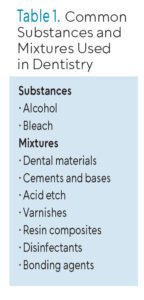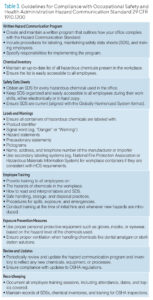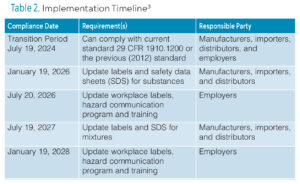
Update on the OSHA Hazard Communication Standard
With training, documentation, and compliance, dental practices can smoothly adapt to the new requirements while remaining focused on the health and safety of both patients and clinicians.
The Occupational Safety and Health Administration (OSHA), a division of the United States Department of Labor, was created in 1970 to protect workers from on-the-job hazards.1 Prior to OSHA’s existence, approximately 14,000 people were hurt or killed on the job each year. By 2021, that number had fallen to 5,190 while the workforce doubled to more than 143 million workers.1 The OSHA Hazard Communication Standard (HCS), often referred to as the “Right to Understand” standard, plays a pivotal role in safeguarding workers from chemical hazards in the workplace.1 Initially established in 1983 and updated in 2012 to align with the third revision of the Globally Harmonized System (GHS), the HCS provides guidelines for classifying hazardous chemicals and communicating their risks through labels and safety data sheets (SDS).2 In July 2024, OSHA introduced key updates to the GHS seventh revision to further enhance chemical safety, particularly for industries, including dentistry, in which hazardous substances are a routine part of daily operations.
Dentists and dental staff routinely work with chemicals, such as disinfectants, acids, sterilants, adhesives, and impression materials, many of which pose health risks if mishandled. The 2024 HCS revisions are particularly significant for dentistry, where staff must navigate a variety of chemical hazards in small, patient-centered environments.
Why Changes Are Needed
 Manufacturers and importers of chemicals must comply with OSHA HCS as they are responsible for providing information about the hazards contained in the chemicals they produce or ship. Employers that utilize chemicals in the workplace must also comply with the OSHA HCS because they are responsible for worker safety with chemicals in their setting.3 The updated standard improves worker protections, decreases workplace illness or injury, addresses issues since the 2012 update, and better informs employees about chemical hazards.2
Manufacturers and importers of chemicals must comply with OSHA HCS as they are responsible for providing information about the hazards contained in the chemicals they produce or ship. Employers that utilize chemicals in the workplace must also comply with the OSHA HCS because they are responsible for worker safety with chemicals in their setting.3 The updated standard improves worker protections, decreases workplace illness or injury, addresses issues since the 2012 update, and better informs employees about chemical hazards.2
The latest HCS update provides several benefits to workers, most importantly, clarification. One major point of clarification is the definition of substances and mixtures. Substances are single chemicals such as alcohol or bleach. Mixtures are combinations of substances such as dental materials and cements.
The update also provides guidance for emerging technology. New classifications and categories have been developed such as explosives and aerosols. Aerosols, such as spray adhesives, and explosives, such as nitrous oxide and hydrofluoric acid used in ceramic etch, are routinely used in dentistry. Finally, label warnings or precautionary statements have been streamlined for easier understanding. Table 1 provides examples of substances and mixtures used in dentistry.
Key Changes in the 2024 Update
- Labeling for Small Containers The updated rule introduces provisions for small containers (100 mL or less), allowing simplified labeling to maintain legibility. Extremely small containers (3 mL or less) may only require product identifiers in certain cases. This is particularly relevant for dental offices handling small quantities of chemical products such as etchants and bonding agents.
- SDS Enhancements SDS now require additional details, including the disclosure of concentration ranges for hazardous components and expanded information on chemical reaction products. These updates aim to improve transparency while protecting trade secrets, ensuring that both workers and first responders have the information needed to mitigate risks.
- Revised Hazard Classification The updates refine the classification process for physical and health hazards. For example, expanded hazard categories for flammable gases and aerosols and new classifications for hazards not otherwise specified provide clearer guidance on labeling and handling chemicals in dental settings.
- Precautionary Statements Updated precautionary statements on labels and SDS offer enhanced guidance on safe chemical handling, storage, and disposal, reducing the likelihood of workplace incidents.
- New Pictogram Requirements Desensitized explosives are now represented in the flame pictogram and hazards not otherwise classified are included under the exclamation mark pictogram. These visual aids enhance understanding for all staff, including nonEnglish speakers or those with limited literacy.
- Harmonization With Other Agencies The 2024 rule integrates labeling requirements with the Department of Transportation, eliminating duplicative labels for bulk shipments. This is particularly beneficial for dental suppliers distributing chemicals in large quantities.3
Implementation Timeline for the 2024 Update
Chemical manufacturers and importers must comply with the new rule for substances by January 2026 and mixtures by July 2027. Employers, including dental offices, have an additional 6 months to implement updates in their Hazard Communication Programs (HCP) and employee training. Table 2 outlines specific dates and requirements for compliance with the 2024 HCS update.
![]() Hazard Communication in Dental Practices
Hazard Communication in Dental Practices
Dental practices must comply with the OSHA Hazard Communication Standard 1910.1200.4 The required components of compliance include developing and maintaining a written HCP; ensuring accessible and up-to-date inventory of all chemicals used in the practice with corresponding SDS, formerly known as material safety data sheets; proper labeling of all secondary chemical containers, including those for chairside mixes; and OSHA-mandated training to all staff regarding chemical hazards and proper handling.4
All components of the HCP must be documented in a written or electronic format that workers can access at all times. Poor record keeping is a common compliance violation.5 Table 3 outlines specific guidelines for dental practices to ensure compliance with the OSHA HCS 1910.1200.
 There are specific considerations for compliance with the OSHA HCS for dental practices. First, training and education are key. OSHA HCS updates mandate revised training to familiarize staff with new labeling requirements and SDS formats. For dental teams, this includes guidance on handling chemical spills, waste disposal, and exposure response protocols.
There are specific considerations for compliance with the OSHA HCS for dental practices. First, training and education are key. OSHA HCS updates mandate revised training to familiarize staff with new labeling requirements and SDS formats. For dental teams, this includes guidance on handling chemical spills, waste disposal, and exposure response protocols.
Second, small containers or secondary containers must be properly labeled.4 Many dental materials, such as bonding agents and sealants, are stored in small containers. The simplified labeling requirements make it easier for dental offices to comply while ensuring staff can easily identify hazards.
Third, the new or expanded hazard categories must be assessed. Dental practices may need to reassess their inventory to ensure proper storage and handling of flammable or reactive substances, such as certain dental materials. Finally, the HCS must be integrated into the existing infection control policies and procedures.3 Hazard communication overlaps with infection control protocols, especially when dealing with sterilants and aerosols. Updated precautionary statements and hazard classifications will help ensure safer practices when disinfecting operatory spaces or handling sharps.
Navigating the complexities of OSHA regulations can be challenging for dental practices, especially smaller ones. The following strategies can help. First, appoint a designated OSHA or infection control coordinator to oversee compliance efforts, including maintaining updated SDS, conducting training, and ensuring adherence to labeling and record-keeping requirements. Collecting and maintaining a chemical inventory with updated SDS is time intensive and requires designated work time to complete.
Second, provide staff with comprehensive training on the updated HCS, emphasizing new labeling standards and hazard classifications. Third, use periodic audits or reviews of the workplace to identify potential hazards, ensure proper labeling of chemical containers, and verify that SDS are readily accessible. Fourth, regularly update documentation including training, record keeping, and monitoring (like the 2024 update). Finally, leverage resources and tools to support and to stay informed about regulatory changes.
Conclusion
The 2024 updates to OSHA’s HCS represent a significant step forward in protecting workers across all industries, including dentistry. By improving the clarity and accessibility of hazard information, these changes empower dental professionals to create safer workplaces. Through proactive training, updated documentation, and diligent compliance, dental practices should be able to seamlessly integrate the new requirements while continuing to prioritize the health and safety of their teams and patients.
References
- Occupational Safety and Health Administration. All About OSHA. Available at osha.gov/sites/default/files/publications/all_about_OSHA.pdf. Accessed November 23, 2024.
- Occupational Safety and Health Administration. OSHA’s Final Rule to Amend the Hazard Communication Standard. Available at osha.gov/hazcom/rulemaking. Accessed November 23, 2024.
- Occupational Safety and Health Administration. Questions and Answers for OSHA’s Update to the HCS Final Rule. Available at osha.gov/sites/default/files/HCS_Q-and-As.pdf. Accessed November 23, 2024.
- Occupational Safety and Health Administration. Hazard Communication Standard 1910.1200. Available at osha.gov/laws-regs/regulations/standardnumber/딦/딦.1200Accessed November 23, 2024.
- Garland KV Dental record keeping is key to quality assurance. Dimensions of Dental Hygiene. 2024; 22(5):14-19.
From Dimensions of Dental Hygiene. March/April 2025; 23(2):18-21.


